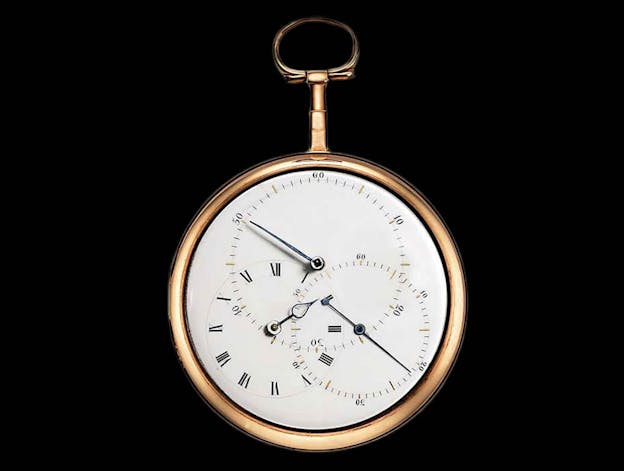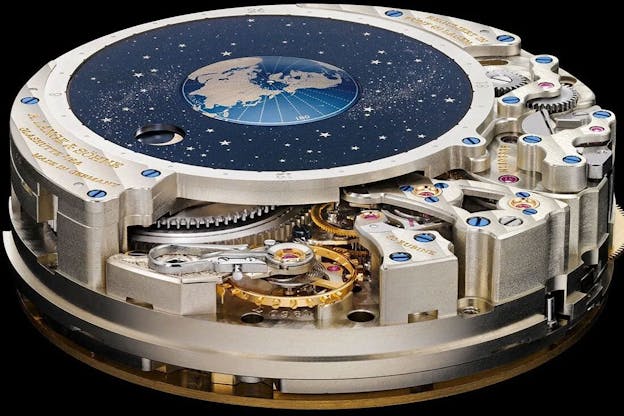View From Above: The A. Lange & Söhne Richard Lange Perpetual Calendar ‘Terraluna’
The Lange Terraluna (180.026FE) is an astronomical complication in every sense of the word.
The world of complicated watchmaking is generally defined by a relatively small set of complications – you’ve got the chronograph and its variants (including the split and flyback); calendars, up to and including the annual and perpetual calendars; chiming complications, including sonneries and repeaters – and that’s about it with the exception of some useful but less frequently encountered complications like the alarm. The most exotic complications in terms of rarity, are astronomical complications – now, the moonphase is not particularly rare, although super high precision moonphase watches like the IWC Portuguieser Eternal Calendar, which has a moonphase accurate to one days’ error in 45 million years, should you have optimistic expectations of your life expectancy (or the longevity of human civilization, for that matter).
Beyond the moonphase, though, are a whole plethora of astronomical complications which are quite rarely seen. These include watches with a sunrise/sunset complication, like the Krayon Everywhere, which is a highly unusual – I think actually unique – example of the complication, inasmuch as the Everywhere can show the correct sunrise/sunset times for pretty much any location on Earth; most sunrise/sunset watches have cams that are specific to a particular location (the famous Patek Graves Supercomplication, for instance, has cams for New York). Watches with planispheric star charts, which show the stars and other celestial objects visible above the horizon, like the Patek 5102 Sky-Moon Celestial, are even more unusual – it may be that I don’t travel in the right circles but I’ve never actually seen a watch with a star chart on anyone’s wrist, though I’ve gawked at plenty through vitrines at trade shows.
Watches that show the actual positions of the planets relative to each other, including the Sun, Moon, Earth, and sometimes the planets visible from Earth as well, are probably the rarest and very few brands or independents have ever produced them. To say that they appeal to a niche audience is to understate the narrowness of their appeal to put it mildly, but they are fascinating for their ability to make you feel as if you have a sort of cosmic microcosm on your wrist – some of my favorites are the Planetarium, Astrolabium, and Tellurium watches in the Ulysse Nardin Trilogy Of Time, and the planetarium complications made by Christiaan Van Der Klaauw. Between the narrow if considerable appeal of the watches, and the challenges involved in calculating and constructing the gear trains (the fourth wheel in a movement rotates once per minute; if you want to put Saturn in a watch, you’ll need to step that down to one rotation every 29.4 years) they are apt to remain rare for the foreseeable future. Probably the unforeseeable future too.
Planetarium style complications are basically wrist-sized versions of mechanical models of the solar system known collectively as orreries. These can be powered by clockwork, or turned by hand, and are named for Charles Boyle, Fourth Duke Of Orrery, although the Greek Antikythera device predates the good Duke by a couple of thousand years. A sub-class of orreries show just the position of the Earth, Sun, and Moon relative to each other and this brings us by a somewhat long, winding, and digressive road to the A. Lange & Söhne Richard Lange Perpetual Calendar Terraluna, originally launched in 2014.

The Terraluna is as is typical for Lange, a lot of watch and I do mean a lot. Not all Lange watches are large in size (although they tend to have a lot of what you might call horological throw weight) but the Terraluna is 45.5mm x 16.5 mm. There are however several reasons for the mass. For one thing the watch has a very long power reserve – 336 hours, which is fourteen days, the power coming from two very large mainspring barrels. As the name says, it’s also a perpetual calendar, with a big date display, indications for the day of the week and the month, a very demure and unobtrusively tasteful leap year indication at roughly 2:30 on the dial, and a power reserve indication at 6:00 that gives the watch the slight appearance of a sly smile on its face.
The overall dial layout is a sort of modified regulator design, with the seconds, hours, and minutes each in its own subdial. The term “regulator” originally referred to high precision pendulum clocks and was coined in the early 19th century, when such clocks began to be used as time references for other clocks and also to time astronomical transits in observatories, although as the years went by the word began to be used somewhat inexactly and often was applied to clocks which aspired to precision more than they achieved it. The dial of the Terraluna is based on an historic pocket watch made in 1807 by Johann Heinrich Seyffert, a Dresden watchmaker and astronomer; the watch is a pocket chronometer created for aiding the explorer and naturalist Alexander von Humboldt in making observations and fixing navigational positions.

All that is still more or less the tip of the iceberg. The Terraluna’s perpetual calendar indications all jump simultaneously at midnight and in order to maintain even delivery of energy to the balance, both during the switching of the calendar indications and also over the very long power reserve, the Terraluna is fitted with a train remontoir. This is a constant force mechanism which is essentially a sort of secondary mainspring, which is periodically rewound by the primary mainspring (or mainsprings, in this case). Generally a remontoir will ensure exactly the same amount of torque delivery to the escapement and balance over the entire power reserve, with the caveat that at the very end of the power reserve, there is no longer enough energy left in the mainsprings to rewind the remontoir. The remontoir in the Terraluna is on the movement fourth wheel and is rewound once every ten seconds.

It is often said albeit with a use of slang that seems a bit antithetical to the spirit of watchmaking at Lange, that Lange watches are business in the front and party in the back and so it is with the Terraluna. If you are going to have a piece of horological exotica like a remontoir – the spring remontoir on top of everything else has a distinguished and noble ancestry, having been invented by John Harrison for his H4 marine chronometer – you would like to be able to see it and the remontoir is visible just to the upper right of the balance proper.

The remontoir, which is visible under an openworked bridge, is controlled by a pivoting lever with two ruby pallets; just below is the steel capped cock for the escape wheel, and then the balance itself. The balance is a classic piece of work from Lange, with a swan’s neck regulator for adjusting beat; the bronze colored lever to the lower left is the stop seconds lever, for stopping the balance when setting the watch. The visible parts of the movement form a crescent border around the disk carrying the Earth and Moon – a bit of an echo of the lunar theme as the shape’s like a crescent Moon.
The disk shows the Earth as seen from a vantage point above the North Pole, with the Moon rotating around it and the balance represents the position of the Sun with respect to the Earth and the Moon. The Earth rotates once every 24 hours and is therefore a sort of impromptu world time indication – if you look closely you can see that the 0º longitude line for the meridian at Greenwich is marked, as are the meridians an hour offset from GMT. If you change time zones and need to reset the time, there’s a button on the case flank at 10:00 as seen from the back (and at 2:00 as seen from the front) which decouples the Earth disk from the hand-setting train, so that you can set the correct local time without changing the position of the Earth relative to the Sun and Moon.

The Moon cut-out rotates around the Earth once every synodic lunar month – as opposed to a sidereal lunar month; a synodic month is defined by the return of the Moon to the same position in its orbit with respect to the Sun as seen from the Earth, and a sidereal lunar month, by the return of the Moon to the same position with respect to a fixed star; as with solar and sidereal days, there is a slight but definite difference. The synodic month, thanks to the very complicated orbital mechanics of the Moon and Earth, varies slightly in length from one month to the next but the average is 29 days, 12 hours, 44 minutes, and approximately 9.6 seconds, which is the standard for calculating moonphase gear trains and for evaluating precision. The Terraluna moonphase is accurate to one day’s precision every 1058 years. The moonphase disk shows the amount of sunlight falling on the lunar surface with respect to the Sun, since the sunlit part of the moonphase disk always faces in the direction of the balance.

There are a grand total of 2,016 stars laser etched on the star disk surrounding the Earth and Moon. As a subtype of orrery, this complication is called a lunarium – traditionally a lunarium model would use a lit candle to represent the Sun. A slightly more complex version of the lunarium is the tellurium, which also shows the tilt of the Earth’s axis with respect to the Earth’s orbital plane as it orbits the Sun, although as far as I’m aware the only wristwatch tellurium is Ulysse Nardin’s Tellurium watch in the Trilogy of Time collection.

The perpetual calendar of course can also be thought of as an astronomical complication, inasmuch as the need for a Leap Year every four years is a result of the fact that it does not take a nice neat whole number of days for the Earth to orbit the Sun – the total is approximately 365 and a quarter days, so the Gregorian calendar adds an extra day every four years to keep the calendar synchronized with the Earth’s actual orbit. I think the Terraluna is an immensely satisfying watch, perhaps the most interesting that Lange has ever made (which is saying something – Lange has made a lot of interesting watches).
Every part of the watch, from the overall design to the choice of complications and how they’re implemented, is well integrated with every other part and the whole thing is a sort of mechanical tribute to the poetry of astronomy, as well as its pursuit of exactness in observation. Sure, it’s a big watch but the size is a purposeful consequence of the design and its roots in precision pocket chronometers, and the lunarium complication, after all, is better served by a large than a small canvas; the only objection to be made against some astronomical complications is that if the watch is on the smaller side the visual effects are lessened. The Terraluna is a breathtaking example of the sober, precision-obsessed side of A. Lange & Söhne perfectly balanced with a kind of baroque exuberance – a watch for very special occasions, maybe, but one that it would be fascinating to watch every day as well.

